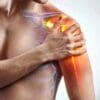Can Shoulder Pain Be a Result of a Shoulder Sprain?
Shoulder pain is a pervasive issue that affects millions of people worldwide, including a significant portion of the Indian population. Whether it’s an acute injury or a chronic condition, shoulder pain can drastically impact your daily activities and overall quality of life. But can shoulder pain be a result of a shoulder sprain? Let’s dive deep into this question to uncover the connection between shoulder pain and shoulder sprains, and what you can do to alleviate this discomfort.
Understanding Shoulder Sprains
What is a Shoulder Sprain?
A shoulder sprain occurs when the ligaments in the shoulder are stretched or torn. Ligaments are tough bands of fibrous tissue that connect bones to each other, providing stability to the joint. In the shoulder, these ligaments can become injured due to various reasons, such as:
– Overextension: Stretching the shoulder beyond its normal range of motion.
– Direct Impact: A blow or fall that puts excessive force on the shoulder.
– Repetitive Motion: Activities that require repeated shoulder movements, such as swimming or throwing.
Symptoms of a Shoulder Sprain
The symptoms of a shoulder sprain can vary depending on the severity of the injury. Common symptoms include:
– Pain: Immediate or delayed pain in the shoulder area.
– Swelling: Swelling around the shoulder joint.
– Bruising: Discoloration of the skin around the shoulder.
– Limited Range of Motion: Difficulty moving the shoulder without pain.
– Tenderness: Sensitivity to touch in the affected area.
The Connection Between Shoulder Sprains and Shoulder Pain
How a Shoulder Sprain Causes Pain
When a shoulder sprain occurs, the damaged ligaments can cause significant pain and discomfort. The pain is typically localized around the shoulder joint and can radiate down the arm or up into the neck. The severity of the pain often correlates with the extent of the ligament damage. Minor sprains may cause mild discomfort, while severe sprains can result in intense, debilitating pain.
Inflammation and Swelling
One of the body’s natural responses to injury is inflammation. When a ligament in the shoulder is sprained, the surrounding tissues become inflamed, leading to swelling and increased pain. This inflammation can also compress nearby nerves, exacerbating the pain and potentially causing tingling or numbness in the arm.
Impact on Daily Activities
Shoulder pain resulting from a sprain can significantly affect your ability to perform daily activities. Simple tasks like lifting objects, reaching overhead, or even sleeping can become challenging. This can lead to a decrease in your overall quality of life and may require adjustments to your routine to avoid further aggravation of the injury.
Diagnosing Shoulder Sprains
Medical Evaluation
If you experience persistent shoulder pain, it’s crucial to seek medical attention for an accurate diagnosis. A healthcare professional will conduct a thorough evaluation, which may include:
– Physical Examination: Assessing the range of motion, swelling, and tenderness in the shoulder.
– Imaging Tests: X-rays, MRI, or ultrasound to visualize the extent of the ligament damage.
Differential Diagnosis
Shoulder pain can result from various conditions, so it’s essential to rule out other potential causes, such as:
– Rotator Cuff Injuries: Damage to the muscles and tendons surrounding the shoulder joint.
– Bursitis: Inflammation of the fluid-filled sacs (bursae) that cushion the shoulder joint.
– Arthritis: Degeneration of the shoulder joint due to wear and tear or autoimmune conditions.
Treatment for Shoulder Sprains
Rest and Immobilization
One of the primary treatments for a shoulder sprain is rest. Reducing movement in the affected shoulder allows the ligaments to heal. Immobilization with a sling or brace may be recommended to prevent further injury.
Ice and Heat Therapy
Applying ice to the injured shoulder can help reduce inflammation and numb the pain. After the initial swelling subsides, heat therapy can promote blood flow and aid in the healing process.
Medications
Over-the-counter pain relievers, such as ibuprofen or acetaminophen, can help manage pain and reduce inflammation. In severe cases, a healthcare provider may prescribe stronger medications or corticosteroid injections.
Physical Therapy
Once the initial pain and swelling have subsided, physical therapy can be beneficial in restoring strength and flexibility to the shoulder. A physical therapist will design a personalized exercise program to help you regain mobility and prevent future injuries.
Surgical Intervention
In rare cases where the ligament damage is severe and does not respond to conservative treatments, surgical intervention may be necessary. Surgery aims to repair or reconstruct the damaged ligaments to restore shoulder stability.
Prevention Tips
Strengthening Exercises
Engaging in regular shoulder-strengthening exercises can help prevent sprains and other injuries. Focus on exercises that target the muscles around the shoulder joint, such as:
– Rotator Cuff Exercises: Strengthening the rotator cuff muscles to provide stability.
– Shoulder Blade Squeezes: Improving posture and shoulder alignment.
– Resistance Band Workouts: Enhancing overall shoulder strength and flexibility.
Proper Technique
Whether you’re an athlete or someone who engages in repetitive shoulder movements, using proper technique is crucial. Ensure that you’re using the correct form and not overexerting your shoulder joint.
Gradual Progression
When starting a new exercise routine or increasing the intensity of your workouts, do so gradually. Sudden increases in activity can put undue stress on the shoulder ligaments, leading to a higher risk of sprains.
Fitpaa: Your Partner in Shoulder Pain Relief
At Fitpaa, we understand the debilitating impact shoulder pain can have on your life. Our mission is to help you achieve your health and fitness goals through personalized, scientifically-backed solutions. Our AI-driven Metabolism Monitoring and Management Technology ensures that every aspect of your health is optimized for the best results.
How Fitpaa Can Help
Personalized Fitpaa Capsule
Our unique Fitpaa Capsule is designed to address your specific health needs, including shoulder pain management. The capsule includes:
– Medical Exercise Therapy: Tailored exercises to strengthen your shoulder and reduce pain.
– Medical Nutrition Therapy: A customized diet plan to support healing and overall health.
– Cognitive Behavioral Therapy: Techniques to help you stay motivated and committed to your recovery.
Real-Time Guidance
Fitpaa’s real-time guidance technology provides continuous support throughout your recovery journey. Our mobile app offers:
– Virtual Workout Trainer: Guided exercises to follow at your convenience.
– Diet Tracker: Track your nutrition intake with precision.
– Progress Tracking: Monitor your improvements and make necessary adjustments.
Download the Fitpaa App Today
Imagine a life free from shoulder pain, where you can pursue your passions and take care of your loved ones without limitations. Fitpaa is here to make that vision a reality. Download the Fitpaa app today and take the first step towards a healthier, pain-free life. With our comprehensive support and guaranteed results, nothing is impossible!
Your well-being is our mission. Join the Fitpaa community and experience the joy of achieving your health and fitness goals. Don’t let shoulder pain hold you back any longer. Download the Fitpaa app now and start your journey to optimal health and wellness!









